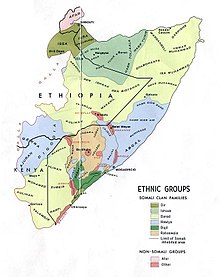Isaaq
The Isaaq (also Isaq or Ishaq written) one of the five or six major clan families of Somaliland .
They make up roughly one fifth of Somalia's population and live in northern Somalia ( Somaliland ) as well as in the Haud area in the neighboring Somali region of Ethiopia .
Ancestry myth and clan structure
The Isaaq can be traced back mythologically to an Arab Sheikh Isaaq as ancestor. He is said to have lived in the 12th or 13th century and was a descendant of ʿAlī ibn Abī Tālib , a son-in-law of Mohammed . Thus the Isaaq claim a descent from the Koreishites . This legend of origin of noble Arab forefathers - which is also found in the Darod clan - probably does not correspond directly to historical reality, but it does reflect the actual cultural influence from Arabia and Arab immigrants and in particular the importance of Islam for the Somali.
Sheikh Isaaq is venerated as a saint by the Isaaq. Oral traditions and descriptions of the saints written in Arabic emphasize the credibility of his lineage, they describe his arrival from Arabia via the port city of Zeila as well as extensive journeys that he is said to have undertaken in what is now northern Somalia / Somaliland and Ethiopia. In addition to his grave in the port of Maydh (Mait), which is visited by pilgrims, numerous shrines are dedicated to him.
The individual subclans consider themselves to be descendants of one of the eight sons of Sheikh Isaaq. They distinguish between the Habar Magaadle , who Isaaq is said to have fathered with his first wife from the Magaadle clan, and the Habar Habuusheed , who are said to have emerged from Isaaq's connection with an Ethiopian woman . The Habar Magaadle include the Garhajis (with the Eidagalla and Habar Yunis as the most important subclans), the Habar Awal, and the smaller clans of the Ayuub and Arab . The four Habar Habuusheed clans form the Habar Tol Jaʿlo alliance , whose numerically largest lineage is the Abokor . (The name Habar Tol Jaʿlo is derived from Ahmed , one of the sons of Habuush, who was nicknamed Tol Jeʿele - “who loves his forefathers”.) This results in the following (simplified) clan structure of the Isaaq:
Habar Magaadle
|
Habar Habuusheed
(Habar Jaʿlo, Habar Tol Jaʿlo, Habar Toljaalo)
|
At a higher level, other clans regard the Isaaq as part of the clan family Dir , while the Isaaq only recognize a connection to the Dir through the maternal lineage. Perhaps they were once a part of the Dir clan, which began to see itself as a separate clan family with increasing numerical importance and claimed an independent Arab ancestry.
History and political situation
Most of the Isaaq area was colonized as British Somaliland at the end of the 19th century . This became independent in 1960 and united with the southern Italian Somaliland dominated by other clans to form Somalia . Many Isaaq soon felt marginalized as a clan and region in the whole of Somalia. In particular, under the rule of Siad Barres since 1969, they were subjected to repression. From the 1980s, the Somali National Movement fought against the Barre government as the Isaaq rebel movement from Ethiopia. In 1988 the conflict escalated into open war, whereupon hundreds of thousands of Isaaq fled to Ethiopia to the refugee camps of Hartisheik , Daror , Camaboker and Rabasso .
After the fall of Barres, the Isaaq were in charge of the declaration of independence in northern Somalia as Somaliland in 1991 . In Somaliland, which has been de facto independent since then , which corresponds to the former British Somaliland, Isaaq form a majority of up to 80% of the population alongside the neighboring clans of Dir and Darod. In Somaliland's parliament, they have made up almost 70% of the MPs since the 2005 general election .
Well-known Isaaq are u. a. Mohammed Haji Ibrahim Egal (Prime Minister of Somalia 1960 and 1967–1969 and President of Somaliland 1993–2004) and Umar Arteh Ghalib (Foreign Minister of Somalia 1969–1977 and Prime Minister 1991).
See also
swell
- ^ Ioan M. Lewis: Understanding Somalia and Somaliland. Culture, History and Society. Hurst, London 2008, ISBN 978-1-85065-898-6 .
- ↑ John Markakis: The Somali in Ethiopia. In: Review of African Political Economy. Vol. 23, No. 70, December 1996, ISSN 0305-6244 , pp. 567-570.
- ↑ Ioan M. Lewis: A Pastoral Democracy. A Study of Pastoralism and Politics among the Northern Somali of the Horn of Africa. Published for the International African Institute by the Oxford University Press, London 1961 (reprint: Lit et al .: Classics in African Anthropology , Hamburg et al. 1999, ISBN 0-85255-280-7 , p. 23f.)
- ^ A b Ioan M. Lewis: Blood and Bone. The Call of Kinship in Somali Society. Red Sea Press, Lawrenceville, NJ 1994, ISBN 0-932415-93-8 , pp. 102-104.
- ^ Lewis, Pastoral Democracy p. 131.
- ↑ Lewis, Pastoral Democracy pp. 155-157.
- ↑ Mark Bradbury: Becoming Somaliland. Progressio, London 2008, ISBN 978-1-84701-310-1 , p. 257; for a more detailed and complex presentation cf. Lewis, Pastoral Democracy p. 157.
- ^ Lewis, Pastoral Democracy , pp. 142, 148.
- ↑ Somaliland - Bienvenue au pays qui n 'existe pas! In: GEO (French edition) N o 338, April 2007.
